Young people's experiences of precarious and flexible work – Main Report
The research report presents findings on young people's experiences of precarious and flexible work. These work conditions included where young people had for example zero hours contracts, low wages, lack of progression opportunities, dissatisfaction with current employment, or varying hours.
5. Types of precarious or flexible working conditions
This chapter addresses RQ1: What are the range of potentially precarious or flexible working conditions experienced by young people in Scotland, as shown in Table 1.2 in Chapter 1. This chapter identifies the type of employment and contract the respondents had and how these were used to determine if they were working in potentially precarious or flexible positions. It also established the sector and size of respondents' workplaces.
Chapter 5 – Key points
Well under half (42%) of the sample were in a permanent job. Significant minorities of young people were in temporary work (14%) and casual work (14%), while a further 10% were in short term or seasonal work.
A full-time contract was the main type of employment contract: 35% of the sample had a full-time job. Many (14%) had zero hours contracts or said they "just turned up for work" (13%).
More than half of young people (55%) were defined as working in precarious or flexible employment: for example lacking a formal contract, in temporary or casual work, or on a zero hours contract.
- - Around half those in precarious/flexible work were in temporary (26%) or casual (25%) work; and
- - Only 14% had a full time contract; most had flexible/no contract, such as zero hours contracts (25%), "just turned up for work" (24%) and varying hours contracts (13%).
Most young people worked in Hotels and Restaurants (23%) and in Wholesale and Retail (21%). Those in precarious or flexible work were particularly likely to work in Hotels and Restaurants (30%) compared with those who were not in precarious or flexible work (15%).
Most young people worked in SMEs (62%); with those in precarious or flexible work more likely than others to work in small organisations (51% compared with 33%).
5.1 Type of employment
The evidence review reported that there is no universally accepted definition of precarious or flexible working, with many reports defining or identifying it in different ways. The European Parliament's 2017 resolution on working conditions and precarious employment (noting that the scope of this resolution does not include the concept of 'flexible work') defines it as 'employment which does not comply with EU, international or national standards and laws and/or does not provide sufficient resources for a decent life or adequate social protection' (Eurofound, 2018). Whereas Benach et al. (2016) described three approaches to defining precarious and flexible working common in existing research: relating it to certain sectors of employment; any employment which is not through a permanent, full-time contract; and relating it to certain attributes of a job such as low wages, limited rights and unequal power balance between employers and individuals. It also stated, however, that flexible employment does not always have to be precarious.These are just two examples of how it can be defined.
The following questions are used to determine the type of employment they held and whether it could potentially be considered precarious or flexible (see section 2.5 for full definition). The results from the questions used are shown in Figure 5.1 and 5.2.
Of the total sample, 42% had a permanent position and a further 6% had a fixed term position over a year. Apprenticeships and those on an internship made up 7% of the sample, with a further 5% who were self-employed or freelancing. Over a quarter (28%) stated they were working in a temporary or casual position and a further 10% were in shorter fixed term or seasonal positions.
Q1a. Thinking about your most recent employment, which of the following best applies to you?
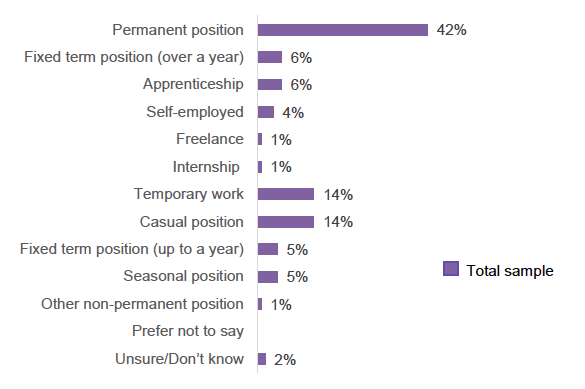
Base (all): 1,043
As shown in Figure 5.2, over a third of the sample were on a full time contract with a further quarter on a part time contract. 14% reported being on a zero hours contract, while 13% said they just turn up for work when asked and 7% were on a varying hours contract. Interestingly, 5% were unsure as to what type of contract or employment they had. The qualitative findings support this, as a small number of participants either presumed they were on a zero hour contract or were unsure if they were. This was discussed above in Section 4.2 Employment rights and conditions.
Q6a. Which of the following describes your most recent employment contract/employment?
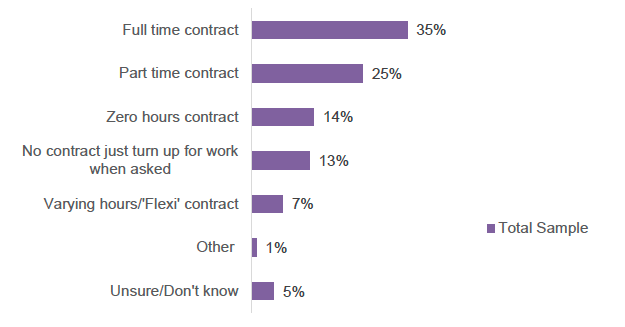
Base (all except those who run their own business): 1,013
Figure 5.3 shows that two thirds (66%) of the total sample had a written, agreed contract with their employer. Just over a quarter (27%) didn't have a written, agreed contract. The full analysis on contracts is reported above in Chapter 4 'Awareness of contractual status'.
Q5. Do you/did you have a contract that is/was written and agreed with your employer?

Base (all): 1,043
Once categorised as working in a precarious/flexible position or not, as per the definition in Box 2.1, 55% of the total sample were classified as working in a precarious or flexible working position and 45% were not. (see Figure 5.4).
Grouped: Q5, Q6a and Q1a. – All without a written contract or has written contract but in a temporary, casual, seasonal position or written contract but Zero hours, varying/flexi hours contracts
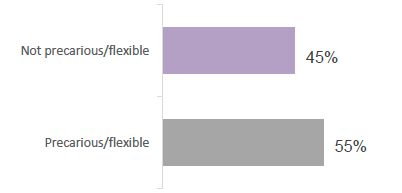
Base (all): 1043
Figure 5.5 shows the breakdown of those identified as working in precarious or flexible positions. Half (49%) of the precarious / flexible sample did not have a written contract and the other half did have a written contract but were either in temporary, casual or seasonal positions (41%) or were in a permanent or fixed-term position of over a year but stated they had a zero hours or varying hours contract (10%). Across all three of these groups, shown in Figure 5.5, 25% stated they were on a zero hours contract (see Figure 5.7 below).
Grouped: Q5, Q6a and Q1a. – All without a written contract or has written contract but in a temporary, casual, seasonal position or written contract but Zero hours, varying/flexi hours contracts
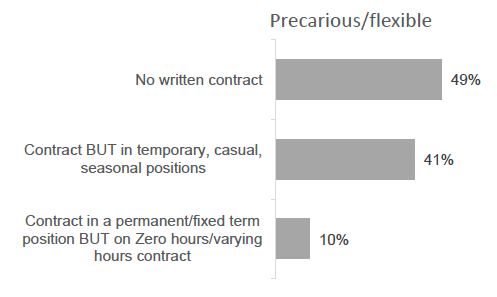
Base (Precarious/flexible): 569
Figure 5.6 shows the proportion of each sub-group that have or recently held each of the different employment types. Those categorised as not precarious or flexible are skewed heavily towards people in permanent positions (70%), with a further 11% in fixed term positions of over a year or an apprenticeship and 6% self-employed. Around half of those in precarious or flexible positions were in temporary (26%) or casual positions (25%) and a further 9% in shorter fixed-term positions up to a year or seasonal positions (9%). There were also 18% of those in precarious / flexible work who were in a permanent position.
Q1a. Thinking about your most recent employment, which of the following best applies to you?
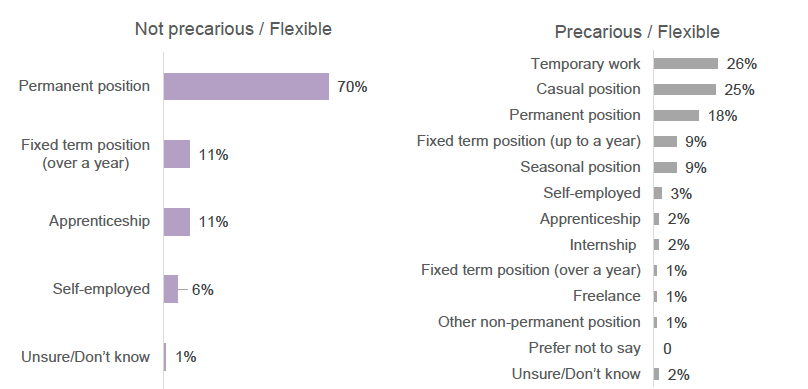
Base (all):
Precarious/flexible 569
Not precarious/flexible 473
When reporting on those who are categorised as in precarious or flexible work, there were differences by age and by education status. The younger group (16-19 year olds) were more likely to be in temporary (34%) or casual (31%) positions compared to the older group (temporary 22%, casual 21%). A UK study (Broughton et al., 2016) supports this as it was found that those undertaking seasonal/casual work include a higher incidence of 16-19 year olds (42%) compared to 20-24 years old (24%).
The older group were more likely to be in a permanent or fixed term position (23%) than the younger group (13%). It is clear that there is some overlap across age and education status as 80% of those in education were more likely to be in temporary, casual or seasonal positions compared to 62% who were not in education. Over a quarter (28%) of those not in education were in a permanent or fixed term position, whereas only 12% of those in education were working in one of these positions.
5.2 Types of employment contracts
Figure 5.7 overleaf shows the type of employment or employment contract the respondents had by the two sub-groups. It is important to note that this question was also used to define those in a precarious or flexible working position and those who were not, therefore all of those who do not work in precarious or flexible positions were either on a full time or part time contract as defined earlier. The figure shows the majority of those not in precarious or flexible positions were on a full time contract (63%), with around a third (34%) stating they were on a part time contract.
The type of employment for those who were in precarious or flexible positions varied with a quarter (25%) stating they were on a zero hours contract, a further quarter (24%) stating they just turn up for work when asked and 13% stating they have a varying hours or flexi-contract. Interestingly, there was also 14% of precarious or flexible workers who state they are in a full time position and 18% in a part time position. Despite being in part or full time positions these workers were categorised as in precarious or flexible work due to not having a contract or their role not being permanent.
Q6a. Which of the following describes your most recent employment contract/employment?
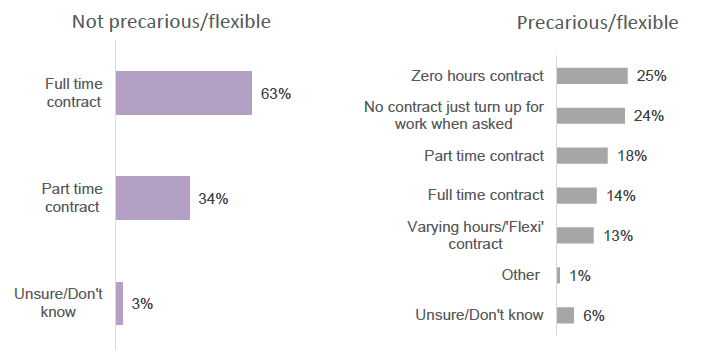
Base (all except those who run their own business):
Precarious/flexible 569
Not precarious/flexible 443
For the precarious or flexible sub-group, differences exist in the type of employment held across the age groups, education status, and whether respondents were financially dependent or not. The older group was more likely to hold a full time contract (17%) or a zero hours contract (28%); while the younger group was more likely to have no contract and just turn up for work (29%) or a part time contract (27%). A similar pattern exists for those in education: those in education were more likely to hold a part time contract (24%) compared to those not in education (10%) and those not in education were more likely to hold a full time contract (20%) compared to those in education (9%). Those who were financially independent were also more likely to have a full time contract (21%) than those who were financially dependent on someone else (9%).
The evidence reviewed does not break the age group down to this level but Taylor (2017) does report that zero hours contracts are often held by young people aged 16-24 years old and are considered high risk for 'precariousness'. The report also states that risk increases if the employees need a regular income as they may feel that they cannot refuse work.
5.3 Sector and size of place of work
The evidence review identified how precarious work can be more prevalent in certain sectors. The TUC's Living on the Edge report cited hospitality, catering and retail as sectors that had higher levels of potentially precarious working positions (TUC, 2016). The quantitative analysis in this study uses a different sector categorisation, nonetheless similar findings have been reported. The results below show that a statistically significantly higher proportion of those categorised as working in a precarious or flexible position worked in the Hotel and restaurant sector compared to those who were not in a precarious / flexible position. There were relatively fewer precarious / flexible workers in Construction, Financial services and Business services (Figure 5.8).
Q25. Which sector do you work in?
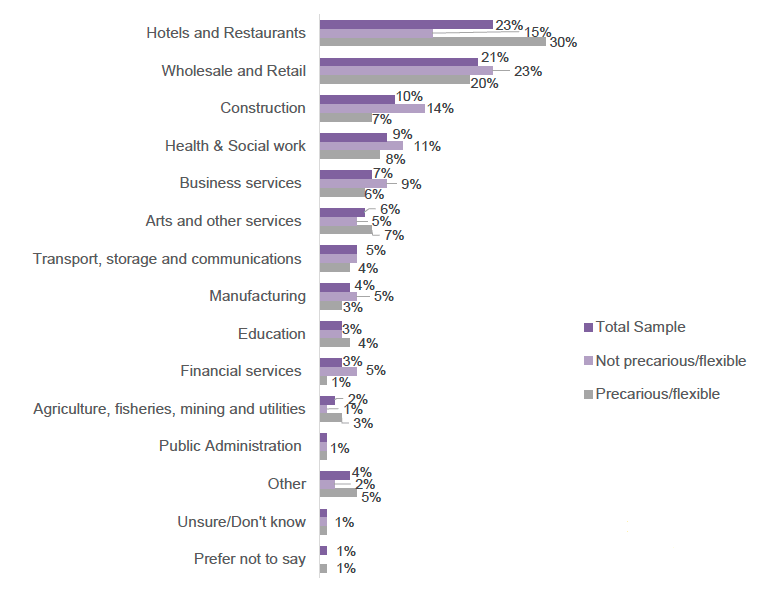
The largest proportion of precarious or flexible workers worked in the Hotel and restaurant sector. This was skewed by the younger group with 36% of 16-19 year olds in precarious or flexible work in this sector compared to 26% of 20-24 year olds. However, there was a higher proportion of 16-19 year olds working in this sector (30%) across the total sample compared to the older age group (20%) which may impact on these findings. Those who were financially dependent on someone else were also more likely to work in this sector (33%) than those who are financially independent (24%).
Those not in education were more likely to work in Manufacturing (5%), Construction (12%) or Transport (7%) than those in education (Manufacturing 1%, Construction 3%, Transport 2%).
Figure 5.9, from the quantitative research, shows that there was a higher proportion (51%) of precarious or flexible workers working in small organisations, and fewer (25%) working for large, corporate organisations compared to those not in a precarious or flexible position (small: 33%, large: 43%).
Q26. What size of organisation do you work for?
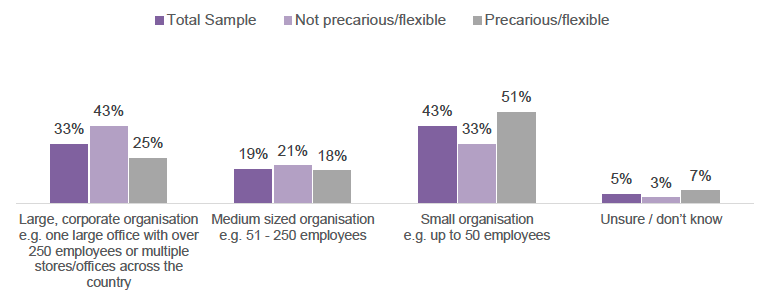
Base (all): 1043
Precarious/flexible 569
Not precarious/flexible 473
Similar to other findings, there were differences within the group of precarious or flexible workers: 20-24 year olds more likely to work in larger organisations (28%) than the 16-19 year olds (19%); while the younger group were more likely to work in smaller organisations than the older group (57% compared with 47%).
Contact
Email: youngpersonguar@gov.scot
There is a problem
Thanks for your feedback